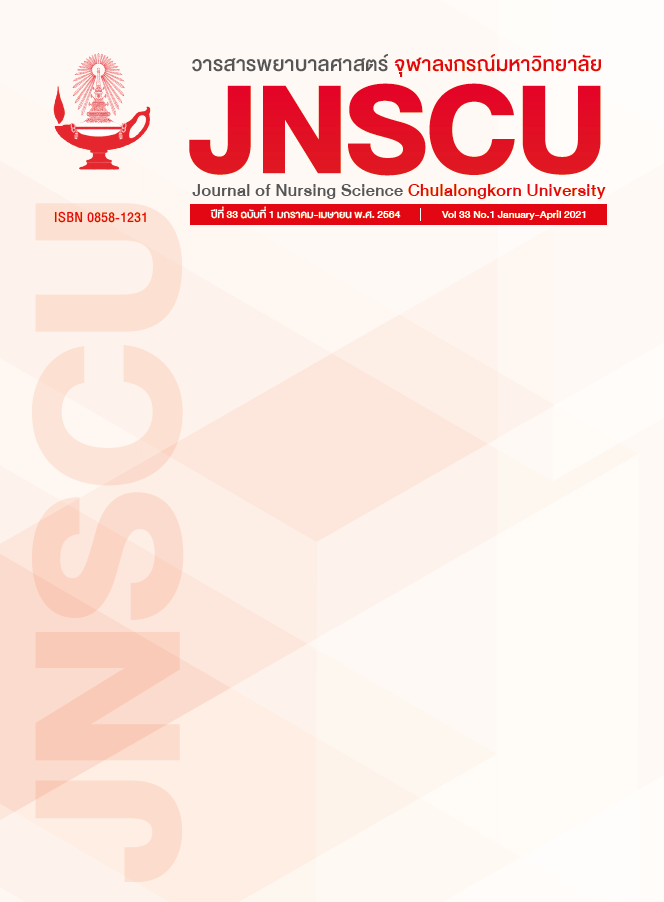การศึกษาประสิทธิภาพการใช้สัญญาณเตือนภาวะวิกฤตระบบ Search out severity และ National Early Warning Score ต่อภาวะใส่ท่อช่วยหายใจหรือการเข้ารับการรักษาในหอผู้ป่วยหนักโดยไม่ได้วางแผนของผู้ป่วยสูงอายุ ในหอผู้ป่วยอายุรกรรม
คำสำคัญ:
การใส่ท่อช่วยหายใจ, การย้ายผู้ป่วยเข้าหอผู้ป่วยวิกฤต, NEWS score, SOS score, ผู้ป่วยสูงอายุบทคัดย่อ
วัตถุประสงค์: เพื่อศึกษาประสิทธิภาพของระบบการให้คะแนนสัญญาณเตือนภาวะวิกฤตของระบบ Search out severity (SOS) และ National Early Warning Score (NEWS) ในการทำนายภาวะใส่ท่อช่วยหายใจหรือการเข้ารับการรักษาในหอผู้ป่วยหนักโดยไม่ได้วางแผนของผู้ป่วยสูงอายุ
แบบแผนงานวิจัย: การศึกษาเชิงวิเคราะห์ไปข้างหน้า
วิธีดำเนินการวิจัย: กลุ่มตัวอย่าง คือ ผู้ป่วยอายุตั้งแต่ 60 ปีขึ้นไป ที่เข้ารับการรักษาในหอผู้ป่วยอายุร กรรม โรงพยาบาลจุฬาลงกรณ์ ตั้งแต่วันที่ 1 พฤศจิกายน พ.ศ. 2562 ถึง วันที่ 31 กรกฎาคม พ.ศ. 2563 การเลือกกลุ่มตัวอย่างแบบเจาะจงตามคุณสมบัติที่กำหนด ได้กลุ่มตัวอย่างจำนวน 85 ราย เก็บข้อมูลโดยใช้แบบประเมินสัญญาณเตือนภาวะวิกฤตตามระบบ NEWS และระบบ SOS นำข้อมูลมาคำนวณหาค่าความไว ความจำเพาะ และความแม่นยำ และทดสอบประสิทธิภาพโดยใช้พื้นที่ใต้กราฟ (Area under the curve: AUC)
ผลการวิจัย: ระบบ NEWS และ SOS ณ ที่ 4 ชั่วโมงก่อนเหตุการณ์มีประสิทธิภาพสูงสุด โดยค่า cut-off ของ NEWS > 7 และ SOS > 4 ให้ผลถูกต้องตามความจริงดีที่สุด (ความไว 71.4%, 64.3% ความจำเพาะ 98.2%, 98.2% ตามลำดับ) โดยมีพื้นที่ใต้กราฟ (AUC) เท่ากับ 0.90 (95%CI 0.81-0.99) และ 0.86 (95%CI 0.75 -0.97) ตามลำดับ และพบว่าประสิทธิภาพในการทำนายลดลงเมื่อเวลาก่อนที่เหตุการณ์ไม่พึ่งประสงค์เพิ่มขึ้น อย่างไรก็ตาม ณ ที่ 8, 12, 24 ชั่วโมงก่อนเกิดเหตุการณ์ก็ยังคงให้ผลถูกต้องตามความจริงในระดับดี-พอใช้ (AUC 0.82, 0.82, 0.75 และ 0.767, 0.79, 0.72 ตามลำดับ)
สรุป: ระบบ NEWS ให้ผลถูกต้องตามความจริงในระดับดีเยี่ยม ในขณะที่ระบบ SOS ให้ผลถูกต้องระดับดี ดังนั้นควรนำระบบ NEWS มาใช้ดักจับความผิดปกติแต่เริ่มต้นและเป็นแนวทางการตอบสนองต่อการเปลี่ยนแปลงของผู้สูงอายุได้อย่างรวดเร็ว ช่วยให้พ้นจากภาวะวิกฤติได้และปลอดภัย และสามารถทำนายผู้ป่วยที่มีอาการทรุดลงได้
References
Suwanpasu S. Aging, Deficit Accumulation and
Frailty. In: Praditpornsilpa K. Textbook
of Geriatric Medicine. 1st ed. Bangkok:
Rungsilp printing Co., Ltd.; 2018. p. 35.
Imamura T, Brown CA, Ofuchi H, Yamagami H,
Branch J, Hagiwara Y, et al. Emergency
airway management in geriatric and
younger patients: analysis of a multicenter
prospective observational study.
The American journal of emergency
medicine 2013; 31(1): 190-6.
Schwartz SJ, Sieber F. The Elderly Patient and
the Intensive Care Unit. In: Barnett SR.
Manual of Geriatric Anesthesia. 1st ed.
New York: Springer; 2013: p. 19.
McGaughey J, O’Halloran P, Porter S,
Blackwood B. Early warning systems and
rapid response to the deteriorating
patient in hospital: a systematic realist
review. Journal of advanced nursing
; 73(12): 2877-91.
Lamantia MA, Stewart PW, Platts-Mills TF,
Biese KJ, Forbach C, Zamora E, et al.
Predictive value of initial triage vital
signs for critically ill older adults.
Western Journal of Emergency Medicine
; 14(5): 453-60.
Nakchuay P, Inprasong L, Tuntrakool W,
Tongbai P, Chantanu P. MEWS: Adult
Pre Arrest Sign with Nurse role 2017;
(3): 186-90. (In Thai)
Jayasundera R, Neilly M, Smith TO, Myint PK.
Are Early Warning Scores Useful
Predictors for Mortality and Morbidity
in Hospitalised Acutely Unwell Older
Patients? A Systematic Review. Journal
of clinical medicine 2018; 7(10): 1-11.
Doi: 10.3390/jcm7100309
Martin LD, Mhyre JM, Shanks AM, Tremper KK,
Kheterpal S. 3,423 emergency tracheal
intubations at a university hospital:
airway outcomes and complications.
The Journal of the American Society of
Anesthesiologists 2011; 114(1): 42-8.
Burger D, Jordan S, Kyriacos U. Validation of
a modified early warning score-linked
Situation-Background-Assessment-
Recommendation communication tool:
A mixed methods study. Journal of
clinical nursing 2017; 26(17-18): 2794-
Miller DM. Establishing inter rater reliability
of the national early warning score
(NEWS). Circulation 2015; 132 (suppl3):
Doi: 10.1161/circ.132.suppl_3.9778
Pullyblank A, Tavaré A, Little H, Redfern E,
le Roux H, Inada-Kim M, et al.
Implementation of the National early
warning score in patients with suspicion
of sepsis: evaluation of a system-wide
quality improvement project. British
Journal of General Practice 2020;
(695): 381-8.
Spångfors, M., Molt, M., & Samuelson, K.
(2020). In-hospital cardiac arrest and
preceding National Early Warning Score
(NEWS): A retrospective case-control
study. Clinical Medicine 2020; 20(1):
-60. Doi: 10.7861/clinmed.2019-0137
Lim WT, Fang AH, Loo CM, Wong KS,
Balakrishnan T. Use of the National Early
Warning Score (NEWS) to identify
acutely deteriorating patients with
sepsis in acute medical ward. Ann Acad
Med Singapore 2019; 48(5): 145-9.
Intachub S, Posri D, Suwannasri J. Outcomes
of using the MEWS (SOS Score) that
affected the severe sepsis and septic
shock in sepsis patients at Medical
Department, Udonthani hospital.
Udonthani Hospital Medical Journal
; 25(1): 85-92.
Mandrekar JN. Receiver operating
characteristic curve in diagnostic test
assessment. Journal of Thoracic
Oncology 2010; 5(9): 1315-6.
Smith MB, Chiovaro JC, O’Neil M, Kansagara
D, Quinones AR, Freeman M, et al. Early
warning system scores for clinical
deterioration in hospitalized patients:
a systematic review. Annals of the
American Thoracic Society 2014; 11(9):
-65.
Pimentel MA, Redfern OC, Gerry S, Collins
GS, Malycha J, Prytherch D, et al.
A comparison of the ability of the
National Early Warning Score and the
National Early Warning Score 2 to
identify patients at risk of in-hospital
mortality: A multi-centre database
study. Resuscitation 2019; 134: 147-56.
Champunot R, Tansuphaswasdikul S,
Kamsawang N, Tuandoung P, Thimsri D.
Application of Search Out Severity (SOS)
Score for Identification of Deteriorating
Patients in General Wards. Buddhachinaraj
Medical Journal 2016; 33(3): 313-25.
(In Thai)
Suwanpasu S, Sattayasomboon Y. Accuracy
of Modified Early Warning Scores for
predicting mortality in hospital: a
systematic review and meta-analysis.
Journal of Intensive and Critical Care
; 2(2): 1-11. Doi: 10.21767/2471-
100029. (In Thai)
Royal College of Physicians (RCP). National
Early Warning Score (NEWS): Standardising
the assessment of acute-illness severity
in the NHS. party Roaw, editor. London:
RCP; 2012.
Kim J, Chae M, Chang HJ, Kim YA, Park E.
Predicting cardiac arrest and respiratory
failure using feasible artificial intelligence
with simple trajectories of patient data.
Journal of clinical medicine 2019; 8(9):
-14. Doi: 10.3390/jcm8091336.
Mitsunaga T, Hasegawa I, Uzura M, Okuno K,
Otani K, Ohtaki Y, et al. Comparison of
the National Early Warning Score (NEWS)
and the Modified Early Warning Score
(MEWS) for predicting admission and
in-hospital mortality in elderly patients
in the pre-hospital setting and in the
emergency department. PeerJ 2019;
: e6947. Doi: 10.7717/peerj.6947
Downloads
เผยแพร่แล้ว
ฉบับ
บท
License

This work is licensed under a Creative Commons Attribution-NonCommercial-NoDerivatives 4.0 International License.
ลิขสิทธิ์ของบทความที่ตีพิมพ์เป็นของวารสารพยาบาลศาสตร์ จุฬาลงกรณ์มหาวิทยาลัย ทั้งฉบับตีพิมพ์เป็นรูปเล่มและเอกสารออนไลน์

